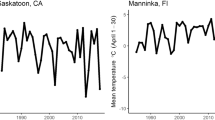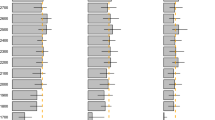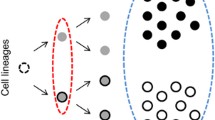Abstract
Phenotypic plasticity has recently been proposed to increase population viability when rapid anthropogenic environmental changes cannot be tracked by means of evolution. This assumes that environmental changes do not constrain phenotypic plasticity itself, which has rarely been examined in natural populations. In areas of climate warming, many long-distance migratory birds breed increasingly late relative to the period of peak food supply, and the temporal mismatch may constrain plastic life-history traits such as nestling growth. We combined 23 years of food availability and breeding data with a 3-year experimental manipulation of nestling growth trajectories in a Central European population of collared flycatchers (Ficedula albicollis) to examine the potential impact of climate-related mistimed breeding on nestling developmental plasticity. Timing of the food peak was predicted by winter climate, and the median hatching date of broods was earlier in springs with earlier food peaks. However, the adjustment of hatching date was incomplete and the population largely missed the food peak in years with very early food peaks. After imposing a temporary, experimental food shortage on nestlings, the extent of compensatory growth in body mass differed among years, and this difference was apparently related to the distance of hatching dates from the yearly food peak. Growth compensation declined with distance from the peak. These results suggest that mistimed phenology may not only create permanently adverse conditions for migratory species but it may also constrain the plastic responses of individuals to temporary disturbances. Therefore, climate change may not only favour but also restrict phenotypic plasticity.



Similar content being viewed by others
References
Arlettaz R, Schaad M, Reichlin TS, Schaub M (2010) Impact of weather and climate variation on hoopoe reproductive ecology and population growth. J Ornithol 151:889–899
Avery MI, Krebs JR (1984) Temperature and foraging success of great tits Parus major hunting for spiders. Ibis 126:33–38
Balbontin J, Møller AP, Hermosell IG, Marzal A, Reviriego M, de Lope F (2009) Individual responses in spring arrival date to ecological conditions during winter and migration in a migratory bird. J Anim Ecol 78:981–989
Beldade P, Mateus ARA, Keller RA (2011) Evolution and molecular mechanisms of adaptive developmental plasticity. Mol Ecol 20:1347–1363
Bize P, Roulin A, Bersier LF, Pflüger D, Richner H (2003) Parasitism and developmental plasticity in Alpine swift nestlings. J Anim Ecol 72:633–639
Blondel J, Maistre M, Perret P, Hurtrez-Boussés S, Lambrechts MM (1998) Is the small clutch size of a Corsican blue tit population optimal? Oecologia 117:80–89
Both C (2010) Flexibility of timing of avian migration to climate change masked by environmental constraints en route. Curr Biol 20:243–248
Both C, Visser ME (2001) Adjustment to climate change is constrained by arrival date in a long-distance migrant bird. Nature 411:296–298
Both C, Visser ME, Verboven N (1999) Density-dependent recruitment rates in great tits: the importance of being heavier. Proc R Soc Lond B 266:465–469
Both C, Artemyev AV, Blaauw B, Cowie RJ, Dekhuijzen AJ, Eeva T, Enemar A, Gustafsson L, Ivankina EV, Järvinen A, Metcalfe NB, Nyholm NEI, Potti J, Ravussin PA, Sanz JJ, Silverin B, Slater FM, Sokolov LV, Török J, Winkel W, Wright J, Zang H, Visser ME (2004) Large-scale geographical variation confirms that climate change causes birds to lay earlier. Proc R Soc Lond B 271:1657–1662
Both C, Bouwhuis S, Lessells CM, Visser ME (2006) Climate change and population declines in a long-distance migratory bird. Nature 441:81–83
Both C, van Turnhout CAM, Bijlsma RG, Siepel H, van Strien AJ, Foppen RPB (2010) Avian population consequences of climate change are most severe for long-distance migrants in seasonal habitats. Proc R Soc Lond B 277:1259–1266
Braendle C, Felix MA (2009) The other side of phenotypic plasticity: a developmental system that generates an invariant phenotype despite environmental variation. J Biosci 34:543–551
Brommer JE, Rattiste K, Wilson AJ (2008) Exploring plasticity in the wild: laying date-temperature reaction norms in the common gull Larus canus. Proc R Soc Lond B 275:687–693
Brzek P, Konarzewski M (2004) Effect of refeeding on growth, development and behavior of undernourished bank swallow (Riparia riparia) nestlings. Auk 121:1187–1198
Carey C (2009) The impacts of climate change on the annual cycles of birds. Philos Trans R Soc Lond B 364:3321–3330
Charmantier A, McCleery RH, Cole LR, Perrins C, Kruuk LEB, Sheldon BC (2008) Adaptive phenotypic plasticity in response to climate change in a wild bird population. Science 320:800–803
Chevin L-M, Lande R, Mace GM (2010) Adaptation, plasticity, and extinction in a changing environment: towards a predictive theory. PLoS Biol 8:e1000357
Cleasby IR, Nakagawa S, Gillespie DOS, Burke T (2010) The influence of sex and body size on nestling survival and recruitment in the house sparrow. Biol J Linn Soc 101:680–688
Easterling DR, Meehl GA, Parmesan C, Changnon AS, Karl TR, Mearns LO (2000) Climate extremes: observations, modelling and impacts. Science 289:2068–2074
Emlen ST, Wrege PH, Demong NJ, Hegner RE (1991) Flexible growth rates in nestling white-fronted bee-eaters: a possible adaptation to short-term food shortage. Condor 93:591–597
Etterson JR, Shaw RG (2001) Constraint to adaptive evolution in response to global warming. Science 294:151–154
Garamszegi LZ, Török J, Michl G, Møller AP (2004) Female survival, lifetime reproductive success and mating status in a passerine bird. Oecologia 138:48–56
García-Navas V, Sanz JJ (2011) The importance of a main dish: nestling diet and foraging behaviour in Mediterranean blue tits in relation to prey phenology. Oecologia 165:639–649
Gebhardt-Henrich SG, van Noordwijk AJ (1991) Nestling growth in the great tit I. Heritability estimates under different environmental conditions. J Evol Biol 4:341–362
Ghalambor CK, McKay JK, Carroll S, Reznick DN (2007) Adaptive versus non-adaptive phenotypic plasticity and the potential for contemporary adaptation to new environments. Funct Ecol 21:394–407
Gienapp P, Teplitsky C, Alho JS, Mills JA, Merilä J (2008) Climate change and evolution: disentangling environmental and genetic responses. Mol Ecol 17:167–178
Hegyi G, Garamszegi LZ (2011) Using information theory as a substitute for stepwise regression in ecology and behavior. Behav Ecol Sociobiol 65:69–76
Hegyi G, Török J (2007) Developmental plasticity in a passerine bird: an experiment with collared flycatchers Ficedula albicollis. J Avian Biol 38:327–334
Hegyi G, Rosivall B, Török J (2006) Paternal age and offspring growth: separating the intrinsic quality of young from rearing effects. Behav Ecol Sociobiol 60:672–682
Hegyi G, Rosivall B, Szöllősi E, Eens M, Török J (2011) Context-dependent effects of nestling growth trajectories on recruitment probability in the collared flycatcher. Behav Ecol Sociobiol 65:1647–1658
Hoffmann AA, Sgró CM (2011) Climate change and evolutionary adaptation. Nature 470:479–485
Honarmand M, Goymann W, Naguib M (2010) Stressful dieting: nutritional conditions but not compensatory growth elevate corticosterone levels in zebra finch nestlings and fledglings. PLoS ONE 5:e12930
Hüppop O, Hüppop K (2011) Bird migration on Helgoland: the yield from 100 years of research. J Ornithol 152:S25–S40
Hurrell JW, Deser C (2010) North Atlantic climate variability: the role of the North Atlantic oscillation. J Mar Syst 79:231–244
Husby A, Kruuk LEB, Visser ME (2009) Decline in the frequency and benefits of multiple brooding in great tits as a consequence of a changing environment. Proc R Soc Lond B 276:845–1854
Husby A, Nussey DH, Wilson AJ, Visser ME, Sheldon BC, Kruuk LEB (2010) Contrasting patterns of phenotypic plasticity in reproductive traits in two great tit (Parus major) populations. Evolution 64:2221–2237
Husby A, Visser ME, Kruuk LEB (2011) Speeding up microevolution: the effects of increasing temperature on selection and genetic variance in a wild bird population. PLoS Biol 9:e1000585
Jones PD, Jónsson T, Wheeler D (1997) Extension to the North Atlantic oscillation using early instrumental pressure observations from Gibraltar and South-West Iceland. Int J Climatol 17:1433–1450
Karell P, Ahola K, Karstinen T, Valkama J, Brommer JE (2011) Climate change drives microevolution in a wild bird. Nat Comm 2:208
Kellermann V, van Heerwaarden B, Sgró CM, Hoffmann AA (2009) Fundamental evolutionary limits in ecological traits drive Drosophila species distributions. Science 325:1244–1246
Laaksonen T, Ahola M, Eeva T, Väisänen RA, Lehikoinen E (2006) Climate change, migratory connectivity and changes in laying date and clutch size of the pied flycatcher. Oikos 114:277–290
Leech DI, Crick HQP (2007) Influence of climate change on the abundance, distribution and phenology of woodland bird species in temperate regions. Ibis 149:S128–S145
Lepczyk CA, Karasov WH (2000) Effect of ephemeral food restrictions on growth of house sparrows. Auk 117:164–174
Lindstrom A, Enemar A, Andersson G, von Proschwitz T, Nyholm NEI (2005) Density-dependent reproductive output in relation to a drastically varying food supply: getting the density measure right. Oikos 110:155–163
Matthysen E, Adriaensen F, Dhondt AA (2011) Multiple responses to increasing spring temperatures in the breeding cycle of blue and great tits (Cyanistes caeruleus, Parus major). Glob Change Biol 17:1–16
McCarty JP (2001) Variation in growth of nestling tree swallows across multiple temporal and spatial scales. Auk 118:176–190
McGuigan K, Van Homrigh A, Blows MW (2008) Genetic analysis of female preference functions as function-valued traits. Am Nat 172:194–202
McNeil K, Newman I, Kelly FJ (1996) Testing research hypotheses with the general linear model. Southern Illinois University Press, Carbondale and Edwardsville
Metcalfe NB, Monaghan P (2001) Compensation for a bad start: grow now, pay later? Trends Ecol Evol 16:254–260
Mitchell JFB, Lowe J, Wood RA, Vellinga M (2006) Extreme events due to human-induced climate change. Philos Trans R Soc Lond B 364:2117–2133
Møller AP, Rubolini D, Lehikoinen E (2008) Populations of migratory bird species that did not show a phenological response to climate change are declining. Proc Natl Acad Sci USA 105:16195–16200
Møller AP, Flensted-Jensen E, Klarborg K, Mardal W, Nielsen JT (2010) Climate change affects the duration of the reproductive season in birds. J Anim Ecol 79:777–784
Moreno J, Lobato E, Morales J, Merino S, Martínez-De La Puente J, Tomás G (2008) Pre-laying nutrition mediates maternal effects on offspring immune capacity and growth in the pied flycatcher. Oecologia 156:727–735
Moussus J-P, Clavel J, Jiguet F, Julliard R (2011) Which are the phenologically flexible species? A case study with common passerine birds. Oikos 120:991–998
Nussey DH, Postma E, Gienapp P, Visser ME (2005) Selection on heritable phenotypic plasticity in a wild bird population. Science 310:304–306
Ozgul A, Tuljapurkar S, Benton TG, Pemberton JM, Clutton-Brock TH, Coulson T (2009) The dynamics of phenotypic change and the shrinking sheep of St Kilda. Science 325:464–467
Palumbi SR (2001) Humans as the world’s greatest evolutionary force. Science 293:1786–1790
Parmesan C (2006) Ecological and evolutionary responses to recent climate change. Annu Rev Ecol Evol Syst 37:637–669
Perrins CM (1991) Tits and their caterpillar food supply. Ibis 133:S49–S54
Postma E (2006) Implications of the difference between true and predicted breeding values for the study of natural selection and micro-evolution. J Evol Biol 19:309–320
Réale D, McAdam AG, Boutin S, Berteaux D (2003) Genetic and plastic responses of a northern mammal to climate change. Proc R Soc Lond B 270:591–596
Reed TE, Schindler DE, Waples RS (2011) Interacting effects of phenotypic plasticity and evolution on population persistence in a changing climate. Conserv Biol 25:56–63
Robinson JA, Hamer KC, Chivers LS (1992) Developmental plasticity in arctic terns Sterna paradisaea and common terns Sterna hirundo in response to a period of extremely bad weather. Ibis 144:344–346
Rosivall B, Török J, Hasselquist D, Bensch S (2004) Brood sex ratio adjustment in collared flycatchers (Ficedula albicollis): results differ between populations. Behav Ecol Sociobiol 56:346–351
Rosivall B, Szöllősi E, Török J (2005) Maternal compensation for hatching asynchrony in the collared flycatcher. J Avian Biol 36:531–537
Rosivall B, Szöllősi E, Hasselquist D, Török J (2009) Effects of extra-pair paternity and sex on nestling growth and condition in the collared flycatcher (Ficedula albicollis). Anim Behav 77:611–617
Rubolini D, Møller AP, Rainio K, Lehikoinen E (2007) Intraspecific consistency and geographic variability in temporal trends of spring migration phenology among European bird species. Climate Res 35:135–146
Saino N, Ambrosini R, Rubolini D, von Hardenberg J, Provenzale A, Hüppop K, Hüppop O, Lehikoinen A, Lehikoinen E, Rainio K, Romano M, Sokolov L (2011) Climate warming, ecological mismatch at arrival and population decline in migratory birds. Proc R Soc Lond B 278:835–842
Sanz JJ, Potti J, Moreno J, Merino S, Frias O (2003) Climate change and fitness components of a migratory bird breeding in the Mediterranean region. Glob Change Biol 9:461–472
Schleucher E (2004) Taxonomy, energetics, and ecology. Physiol Biochem Zool 77:942–949
Sheldon BC, Kruuk LEB, Merilä J (2003) Natural selection and inheritance of breeding time and clutch size in the collared flycatcher. Evolution 57:406–420
Siikamäki P (1996) Nestling growth and mortality of pied flycatchers Ficedula hypoleuca in relation to weather and breeding effort. Ibis 138:471–478
Smallegange E, Fiedler W, Köppen U, Geiter O, Bairlein F (2010) Tits on the move: exploring the impact of environmental change on blue tit and great tit migration distance. J Anim Ecol 79:350–357
Smith HG, Wettermark KJ (1995) Heritability of nestling growth in cross-fostered European starlings. Genetics 141:657–665
Starck JM, Ricklefs RE (1998) Avian growth and development: evolution within the altricial-precocial spectrum. Oxford University Press, Oxford
Szöllősi E, Rosivall B, Török J (2007) Is hatching asynchrony beneficial for the brood? Behav Ecol 18:420–426
Teplitsky C, Mills JA, Alho JS, Yarrall JW, Merilä J (2008) Bergmann’s rule and climate change revisited: disentangling environmental and genetic responses in a wild bird population. Proc Natl Acad Sci USA 105:13492–13496
Thomas DW, Blondel J, Perret P, Lambrechts MM, Speakman JR (2001) Energetic and fitness costs of mismatching resource supply and demand in seasonally breeding birds. Science 291:2598–2600
Tinbergen JM, Verhulst S (2000) A fixed energetic ceiling to parental effort in the great tit? J Anim Ecol 69:323–334
Török J (1986) Food segregation in three hole-nesting bird species during the breeding season. Ardea 74:129–136
Török J, Hegyi G, Tóth L, Könczey R (2004) Unpredictable food supply modifies costs of reproduction and hampers individual optimization. Oecologia 141:432–443
Tøttrup AP, Thorup K, Rainio K, Yosef R, Lehikoinen E, Rahbek C (2008) Avian migrants adjust migration in response to environmental conditions en route. Biol Lett 4:685–688
Umina PA, Weeks AR, Kearney MR, McKechnie SW, Hoffmann AA (2005) A rapid shift in a classical clinal pattern in Drosophila reflecting climate change. Science 308:691–693
Van Asch M, Visser ME (2007) Phenology of forest caterpillars and their host trees: the importance of synchrony. Annu Rev Entomol 52:37–55
van Buskirk J, Mulvihill RS, Leberman RC (2009) Variable shifts in spring and autumn migration phenology in North American songbirds associated with climate change. Glob Change Biol 15:760–771
Végvári Z, Bókony V, Barta Z, Kovács G (2010) Life history predicts advancement of avian spring migration in response to climate change. Glob Change Biol 16:1–11
Visser ME, van Noordwijk AJ, Tinbergen JM, Lessells CM (1998) Warmer springs lead to mistimed reproduction in great tits (Parus major). Proc R Soc Lond B 265:1867–1870
Walsh B, Blows MW (2009) Abundant genetic variation plus strong selection = multivariate genetic constraints: a geometric view of adaptation. Annu Rev Ecol Evol Syst 40:41–59
Wilson AJ, Pemberton JM, Pilkington JG, Coltman DW, Mifsud DV, Clutton-Brock TH, Kruuk LEB (2006) Environmental coupling of selection and heritability limits evolution. PLoS Biol 4:1270–1275
Acknowledgments
We thank M. Herényi, M. Laczi, B. Rosivall and E. Szöllősi for help with the fieldwork. Supported by Országos Tudományos Kutatási Alapprogramok (Grants K75618 to J.T. and PD72117 and K101611 to G.H.), a Bolyai fellowship to G.H., the Erdők a Közjóért Alapítvány and the Pilis Park Forestry.
Conflict of interest
The authors declare that they have no conflict of interest.
Author information
Authors and Affiliations
Corresponding author
Additional information
Communicated by Indrikis Krams.
Electronic supplementary material
Below is the link to the electronic supplementary material.
Rights and permissions
About this article
Cite this article
Hegyi, G., Nagy, G. & Török, J. Reduced compensatory growth capacity in mistimed broods of a migratory passerine. Oecologia 172, 279–291 (2013). https://doi.org/10.1007/s00442-012-2487-5
Received:
Accepted:
Published:
Issue Date:
DOI: https://doi.org/10.1007/s00442-012-2487-5




